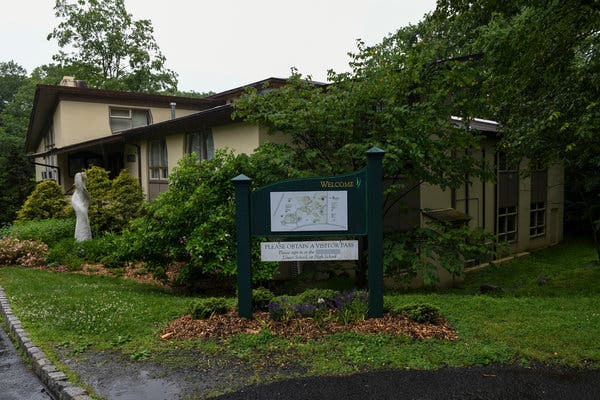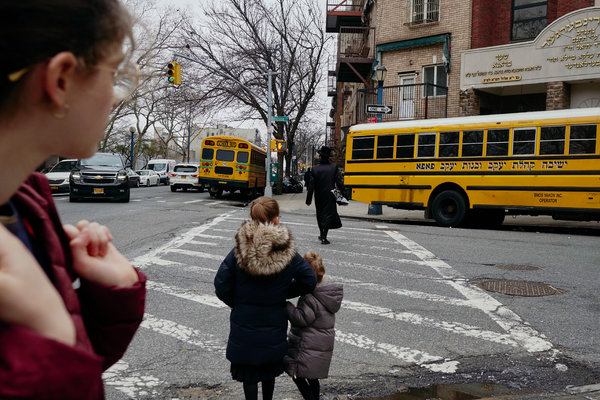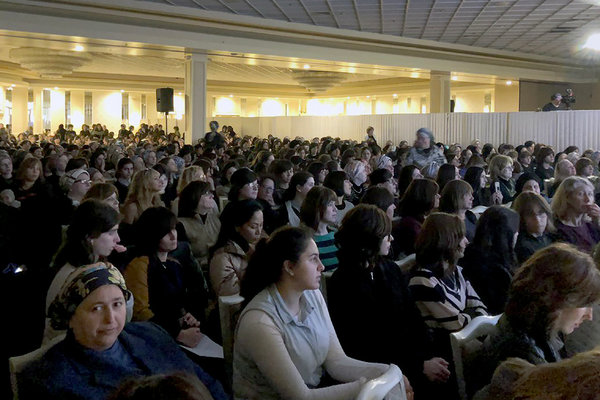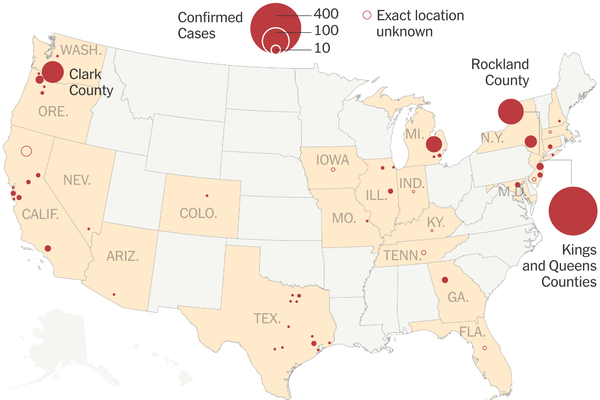[What you need to know to start the day: Get New York Today in your inbox.]
CHESTNUT RIDGE, N.Y. — The mother of an unvaccinated child here in the New York suburbs says eating papaya helps to combat measles. The father of another child who has not been immunized believes that big pharmaceutical companies are paying millions of dollars to doctors, government officials and even judges to bury the truth about vaccine complications.
Another mother says the souls of her children are on a journey that vaccines would impede. “As a parent, for me, a lot of my job is to just not put extra obstacles in that soul’s way,” she said.
All three parents represent an anti-vaccine fervor on the left that is increasingly worrying health authorities. They often cluster around progressive private schools that are part of the Waldorf educational movement, and at the Waldorf school here, 60 percent of the school’s 300 or so students were not vaccinated against measles and other highly contagious diseases as of late last year.
The measles epidemic in the New York region has largely spread among ultra-Orthodox Jewish communities in Rockland County and in New York City. But health authorities fear it could jump to other unvaccinated groups like the ones linked to the children of families who attend Waldorf schools.
Ed Day, the Rockland County executive, has lashed out at the Green Meadow parents and other opponents of vaccine mandates, calling them “mentally nebulous.”
“The anti-vaccination movement is a serious threat to public health,” he said.
The Green Meadow Waldorf School in Rockland County, about 25 miles northwest of New York City, costs roughly $25,000 a year in tuition and is grounded in an educational philosophy that frowns upon rote learning.
The Waldorf method encourages children to learn at their own pace — textbooks are banned until the sixth grade, and technology and smartphones are prohibited altogether. Dance and arts are emphasized as tools to learn, for example, the alphabet.
The Waldorf schools were founded in the early 20th century on the teachings of Rudolf Steiner, a charismatic Austrian educator who preached a philosophy called “anthroposophy” that included eccentric medical theory.
He taught that diseases were influenced by “astral bodies” and that humans can also breathe through their skin. While he did not completely reject the vaccines against smallpox and diphtheria used in his day, he said rosemary baths were better for diphtheria and that smallpox could be avoided by being mentally prepared to confront it.

CreditDesiree Rios for The New York Times
There are about 150 Waldorf schools in North America, including several in the New York region.
Over the last two decades, Waldorf schools across the country have had a spate of disease outbreaks, which is why they are the focus of concern in the measles epidemic.
A Waldorf school in North Carolina had an outbreak of chickenpox in November, the worst the state had seen since 1995. In 2016, a Waldorf school in Calgary, Canada, was affected by an outbreak of highly contagious whooping cough.
Vicki Larson, a spokeswoman for Green Meadow, said the school followed the law and that it was up to parents to decide whether to vaccinate their children.
“There is not a Waldorf position on vaccination,” she said. “It’s not our role.”
Nationwide, 1,022 new cases of measles were reported in the United States as of this month, most of them in New York City and the surrounding suburbs, officials said.
That’s the largest number of new cases since measles was declared eliminated in the United States 20 years ago.
There is a vast body of evidence that shows conclusively that vaccines for measles and other diseases are safe, but some parents of children at the Green Meadow school insisted that the research was outdated or not rigorous enough to allay their suspicions.
Green Meadow first attracted attention this year after parents there successfully sued to overturn a county measure that had barred unvaccinated children from schools. The parents asserted that they had a right to a religious exemption to vaccine mandates.
The measure had been adopted by the Rockland County authorities in an effort to curb the epidemic.
“We need to have our thinking hats on, every single day, every single hour,” said Elizabeth, the mother of a 4-year-old at Green Meadow, who was a plaintiff in the litigation.
She said she started doing “skeptical information gathering” after reading online that children could die from vaccines.
Like other parents who were interviewed for this article, she asked that she be identified only by her first name because she said she was worried about her safety after speaking out.
“When I think about my child, I would want him to know that I took that responsibility seriously,” she added, “and that I gave him time to build the God-given immune system in a way that it is designed to be built.”
She declined to explain which of her religious views made her oppose vaccinations.
Melissa, another Rockland County parent involved in the litigation, said her Buddhist views prevented her from vaccinating her children unless they became very sick.
“We’re taught to live in the present,” said Melissa, whose children do not attend Green Meadow. “Right now, my children are healthy.”
The parents may soon no longer be able to seek religious exemptions. On Thursday, state lawmakers in New York seemed poised to end religious and other nonmedical exemptions for immunizations, overcoming opposition from vaccine skeptics and advocates for religious freedom.
Rockland County has recorded 266 cases of measles over the past nine months, even though more people are getting immunized, according to the latest health data.
Officials fear that hundreds more cases of measles have gone unreported, and Mr. Day issued a third state of emergency two weeks ago.
Dr. Michael L. Weitzman, a professor of pediatrics and public health at New York University, said health authorities are now turning their attention to other pockets of unvaccinated children beyond ultra-Orthodox Jewish neighborhoods, including those in Waldorf schools.
“This is such a sad and preventable problem that can have tragic consequences, not just for the unimmunized and infected child, but for any unimmunized individual who comes in contact with him or her,” Professor Weitzman said.
The Green Meadow school sits amid sprawling hills in the New York City suburbs. Pastel colors are used in decorations to avoid inducing anxiety in children. Dolls, crafted to appear gender neutral, are made of natural products like wool.
Behind the classrooms, 3-year-olds take lessons in the “Forest School,” where they are taught how to build a fire, tap syrup from maple trees and learn poems about nature and the seasons by acting them out.
“We need them to know that the world is a good place, a beautiful place,” said Jessica Oswald, a teacher. “We try to show reverence to the trees, to the bees, to each other.”
In interviews, parents at Green Meadow said their skepticism about vaccines was not rooted in ignorance but in their own research. They said they scoured the internet and public libraries for vaccine findings, then shared their conclusions with one another.
Elizabeth, who said she has a master’s degree in public health policy, called for comparative studies between vaccinated and unvaccinated children over a prolonged period of time.
“Let’s put it on and see how healthy everyone is,” she said.
Vaccine advocates noted that such studies had already been done.
Doctors in Denmark and other countries with national health systems and central medical records have followed hundreds of thousands of children for decades and concluded that vaccines are safe, prevent diseases and do not cause autism.
Some of the parents said they distrusted the medical profession and the Centers for Disease Control and Prevention.
“We could have said that the science on antibiotics was settled a few decades ago,” said Elena, another parent, who said she has degrees in applied mathematics.
“They were successful and prescribed liberally. It was irresponsible not to take them. They were considered one of the biggest advances in modern medicine,” she said. “And now, we are in a place where antibiotic resistance is likely a bigger threat to human existence than any disease for which vaccines are available, due to overuse.”
Another parent, Paul, said, he believes “the science is behind the times on this.”
“There’s a lot of research now that seems to indicate a big negative side to the vaccinations and that not having the natural wild measles also deprives you of some health benefits,” he said.
Health authorities said Paul’s view was absolutely not true, but is typical of the misinformation spreading among vaccine opponents.
Many of these arguments have been embraced or allowed to flourish unopposed at Green Meadow because of the school ethos, even though not all Waldorf parents oppose vaccination.
“People come to them as a kind of withdrawal from the mainstream,” Elisa Sobo, a professor of anthropology at San Diego State University, referring to Waldorf schools.
Professor Sobo has studied opposition to immunization among Waldorf school parents. (She herself is a Waldorf parent, but is supportive of vaccines.)
Pediatricians and epidemiologists said that suspicions about vaccines have emerged largely because the effects of measles and other infections have faded from public memory.
“I’ve seen children die of measles, kids devastated by rubella, children becoming sterile from mumps,” Professor Weitzman said. “Parents can have these kind of opinions because they haven’t seen the devastation that these diseases can cause.”




